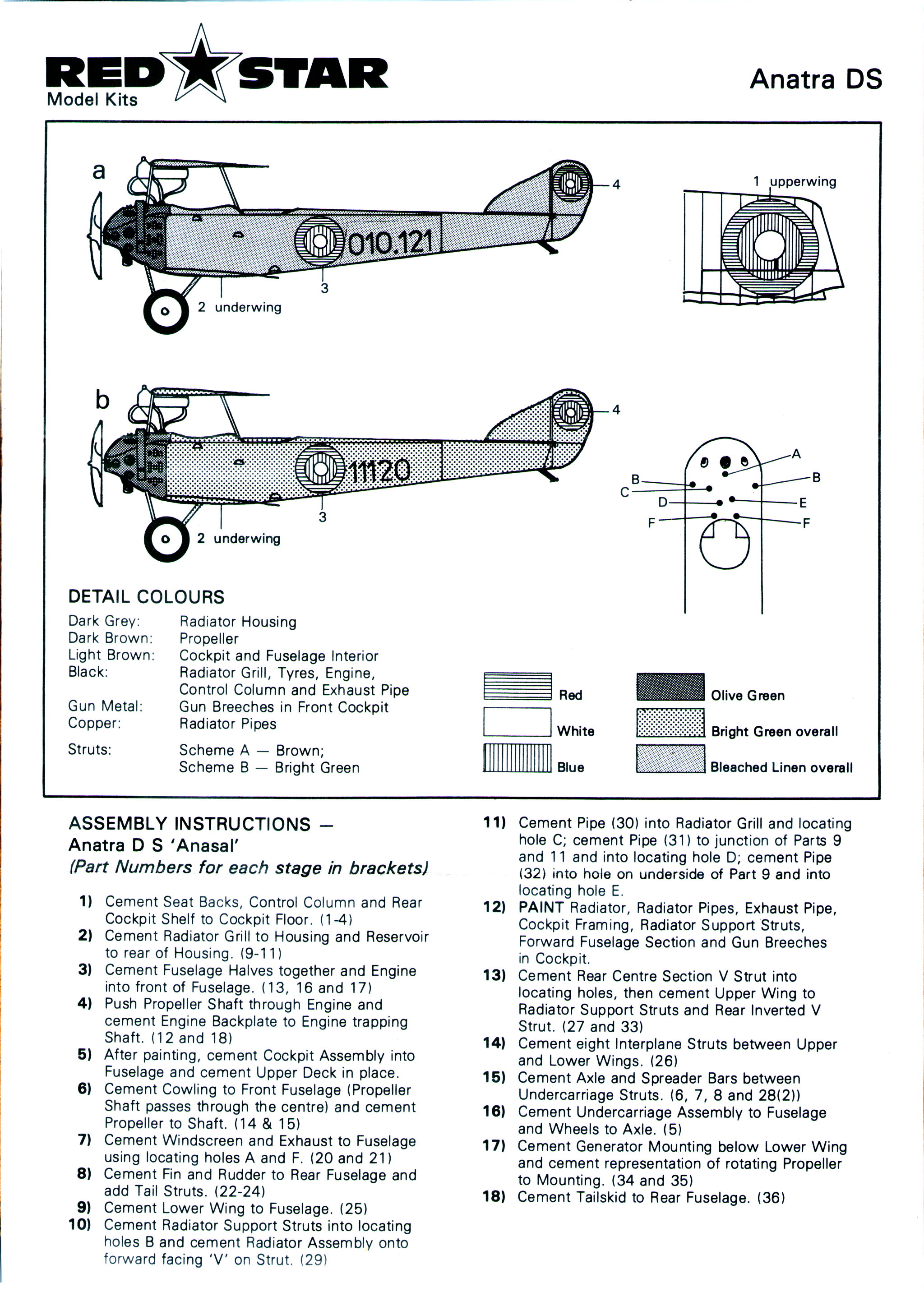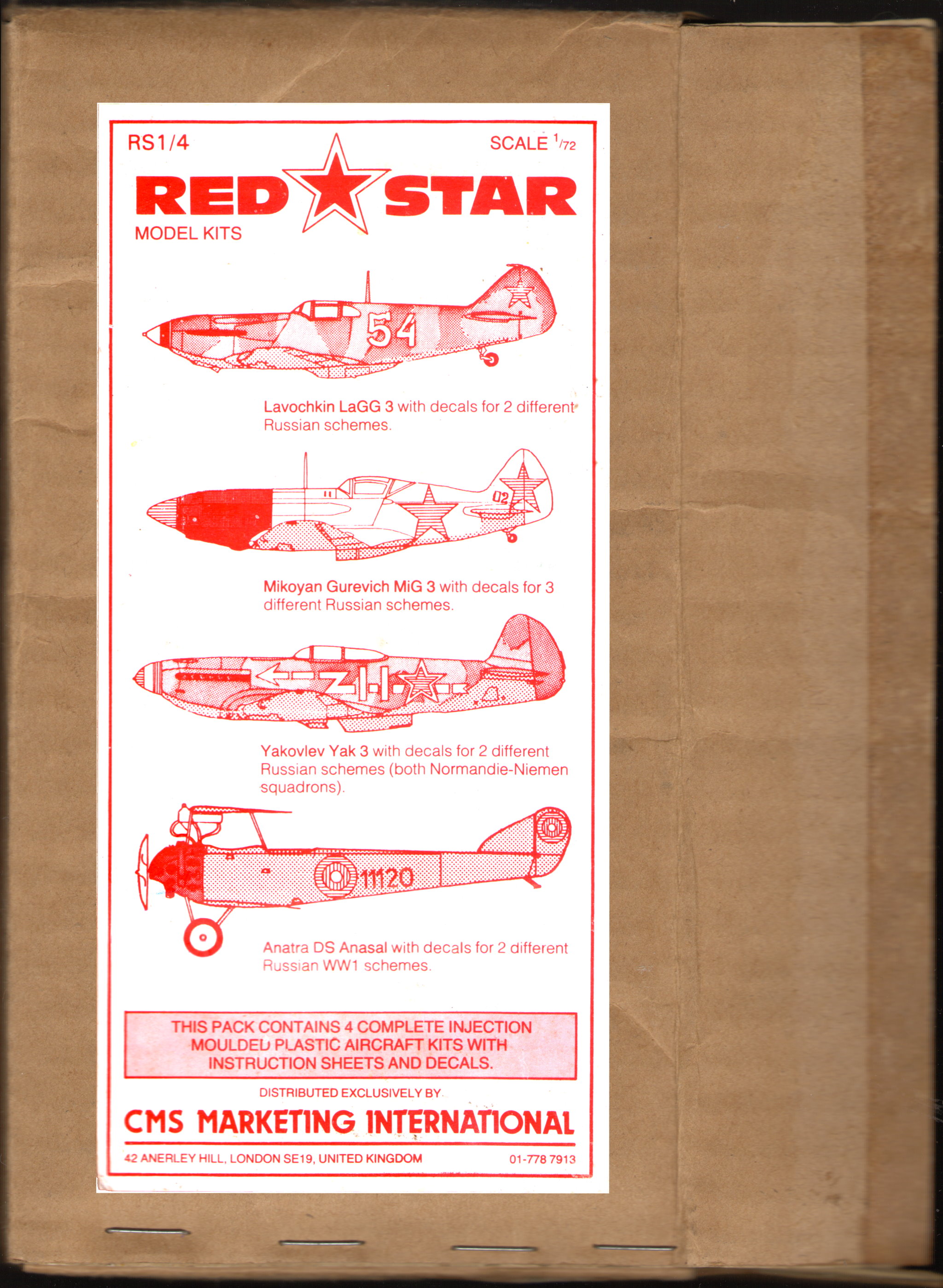
Red Star RS1/4 Anatra Anasal DS, Red Star Model Kits Ltd,
distributed by CMS Marketing International, 1983, four kits pack


SCALE MODELLERS' MARKET PLACE
ANATRA DS
Manufacturer: Red Star (Distributed by CMS Marketing International)
Scale: 1:72nd
Price: Not available separately, only with Red Star Kits 1-4 at £9.85 plus p&p
If you're like me, you probably have never heard of an Anatra before. The best reference I found was The Rand McNally Encyclopedia of Military Aircraft 1914-80. The Anatra DS was a two-seat reconnaissance biplane of 1917 built by an Odessa-based company which had been founded by an Italian banker, A. Anatra. It was in production for only a few months but about 70 were built. Powered by a nine-cylinder Salmson radial engine, it had a top speed of 89½ mph and an endurance of 3½ hours.
Red Star models are injection moulded kits bearing all the hallmarks of Frog and, indeed, the moulds were apparently made by the Frog team. The Anatra bears the Frog reference number F.312 and is moulded in the Soviet Union. The review model was moulded in a semi-transparent white plastic but others have been seen in the familiar Frog mid-grey plastic.
The standard of moulding is excellent with virtually no flash and minimal cleaning up required. Assembly instructions are verbal and take one back to the early days of plastic modelling. How much more efficiently a good diagram can convey information. Two side views are given to illustrate the alternative colour schemes. They go some way to show the assembly of the radiator grill, housing and reservoir but an exploded view would have been much easier and more positive. The numerous holes on the top of the forward fuselage are clearly illustrated by a sketch and this is much appreciated.
Apart from the guesswork with the radiator, the assembly is straightforward and all parts fit well.
The lack of dihedral on the Anatra's wings give it a rather sagging look which is well portrayed by the model.
Decals, designed and produced by Richard L. Ward, are for two machines, 010.21 in bleached linen overall with an olive green nose or 11120 in bright green overall. The latter scheme is illustrated in colour in the reference source given earlier. Both bear Imperial Russian markings.
This model is an unusual and pleasing reproduction of a hitherto uncovered corner of aviation history.
Brian L. Thorne
Scale aircraft modelling, May 1984, Vol.6 N.9"
Red Star
Red Star Model Kits Ltd., 16 Whitecroft Road, Beckenham, Kent, England BR3 3AG
Period: 1983 to date
Of the 169 Frog moulds completed from 1955 to 1977, only six are believed still to remain in Great Britain. Two of these (the Dennis Ambulance and Firefly Dinghy moulds) are with Hornby Hobbies and the other four with Red Star.
These four are the so-called "Russian" moulds completed by Rovex specifically for use in the USSR, but in the end never sent there. After several attempts to sell them to established kit producers, the Novo receivers finally found a buyer in the Red Star company; a small firm with a rather unusual story behind it.
The story of Red Star goes back to 1982 when Jim Chapman — the subsequent founder of Red Star — took a holiday in the Soviet Union. Before departure he made enquiries to discover where he might be able to purchase kits for his own use. Before he left he heard from the relevant Soviet authority, who also advised him that the possibility of importing a range of ex-Frog kits to the West was under active consideration.
On his return home, he contacted the Soviet import agency with a view to offer advice on the proposed import project. The initial advice took the form of a review of the alternative kits available. This led to further meetings where it became obvious that the agents had rather vague ideas on the choice of suitable kit subjects and not much practical knowledge on matters such as packaging and decals (at one point a peel-off/stick-on type of markings was seriously considered, and some test sheets on white backing paper were printed!). The question of finding a suitable distributor was also pending, but in the end the agents choose Capital Models Supply (CMS). See Novoexport for more details of this operation.
During his enquiries for the CMS import project, Jim discovered the existence of the four moulds later acquired by Red Star. Initially he was asked to cost a scheme to acquire and market these moulds as an ancillary project to the main import scheme. Although his report showed this to be feasible, the Soviets did not wish to proceed until the main scheme was well under way.
As by this time he had invested a considerable amount of effort in the project, Jim Chapman was however reluctant to see the moulds disappear to Eastern Europe. He therefore put forward a proposal to a number of people to see if a consortium could be put together to handle the moulds without Soviet involvement. After a number of false starts and changes in the expected participants, a company was arranged to handle the scheme. This was Glenprime Ltd., but the name was soon changed to Red Star Model Kits Ltd.
By July 1983 they were ready to go into production and on October 31st CMS - who had been appointed sole distributor - took delivery of the first 3,000 of the 7.000 four-kit sets ordered by them. In the event, only about 2.000 of these were sold as sets, the balance being repacked singly in polythene bags with header cards, mainly to meet US orders received by CMS in the spring of 1984. Most sets had a red and white label, but a few of the last ones sold after October 1984 had this replaced by a photocopy.
After CMS went into receivership in August 1984, attempts to get the intended backers of CMS' Soviet import scheme to continue were unsuccessful. Jim then put forward various schemes whereby the Soviets could act as their own distributors for at least a limited scheme. When none of these proposals had elicited much of a response by March 1985, Red Star offered to run such a project on behalf of the Soviets and - to ensure that there was no financial risk to the Soviets — offered to surrender Red Star's moulds as payment. This scheme was initially accepted but then the Soviets changed their mind and progress stopped. Other proposals covered an exchange of moulds to enable production to take place in England but this was also turned down.
Finally a simple offer to purchase kits for cash was put forward. This was accepted in December 1985 and an initial range of nine kits (all from the DFI factory) was agreed upon. Of these, the Maryland was subsequently dropped as a small mould defect was found. It was hoped that a further sixteen types (including the Sea Venom and Whitley) would follow later. In addition, the Soviets offered delivery of 1,000 Shackletons from existing stocks.
But nothing has happened since and Red Star are still waiting for their kits. Apparently the Soviets developed cold feet at the last moment and the future of the deal is somewhat uncertain. It is possible that the recent large exports to Eastern bloc countries (to pay for food imports to the nuclear stricken Ukraine) has taken up much of the available capacity. There are two hopeful signs, however. The first is the Soviets' undeniable interest in acquiring the Red Star moulds. The second is the recent changes in Soviet hierarchy. Fresh approaches have recently been made so there is still hope. . .
In anticipation of the first Soviet deliveries, Red Star commissioned new artwork for the Skua, Vengeance and Ventura. In addition, new decals were designed for the Skua and Ventura. This work was done by Dick Ward of Modeldecal, who also did the previous Red Star decals. Meanwhile, production of the first four kits was (temporarily) suspended in March 1987. By then, total production was as follows: MiG-3 12,500, LaGG-3 11,500, Anatra 9,500 and Yak-3 8,500 pieces. Mould problems have necessitated a few small adjustments, as can be seen when comparing with samples produced by Rovex. A small batch of review samples was made in translucent white and bulk production in medium grey.
FROG model aircraft 1932-1976, R. Lines, L. Hellstrom"
| 



